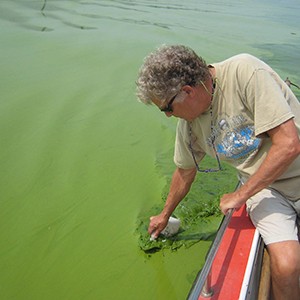NORMAN—University of Oklahoma professors, Karl D. Hambright and Lee R. Krumholz, will lead a global research team to study one of the most common environmental problems—freshwater toxic cyanobacteria (bluegreen algae) blooms, which threaten freshwater lakes and pose substantial health risks to humans, pets, livestock and wildlife. The group will address the fundamental interactions between cyanobacteria and other bacteria co-occurring with the blooms.
“By testing the hypothesis that cyanobacteria are supported through a mutually-beneficial relationship with a mixture of other species of bacteria, we hope to discover new avenues of bloom mitigation,” said Hambright, professor in the Department of Biology, and director of Environmental Studies; and Krumholz, professor in the Department of Microbiology and Plant Biology. Both departments are part of the OU College of Arts and Sciences.
Hambright and Krumholz will address the harmful outbreaks of toxic cyanobacteria that have reached new levels in water bodies around the world with team members: Hans W. Paerl, the University of North Carolina-Chapel Hill; Alan E. Wilson, Auburn University; and Morgan M. Steffen Wurch, James Madison University. Researchers from Australia, Canada, China, France, Germany, Hungary, Israel and New Zealand will assist in developing an enhanced understanding of interactions between cyanobacteria and associated bacteria.
The team will focus on a concept based idea that these blooms constitute complex interactions of cyanobacteria and associated bacteria that co-evolve to form a community of synergistic species, each with a unique metabolic capability critical to the growth, maintenance and demise of the bloom. The team will use: (1) a global genomic survey of cyanobacterial blooms throughout all phases of the bloom; (2) a targeted series of metagenomic and metatranscriptomic surveys; and (3) experimental work focused on interactome species comparison and gene expression in the lab and field sites in China and North America.
 The team also will explore the roles of nutrient inputs, nutrient ratios and various forms of nitrogen on the function and species composition of the bloom. This research aims to understand the unique roles of specific bacterial species on metabolic processes within the bloom and to identify potential new approaches for mitigating harmful cyanobacterial blooms by using a realistic approach based on ecology and evolutionary biology.
The team also will explore the roles of nutrient inputs, nutrient ratios and various forms of nitrogen on the function and species composition of the bloom. This research aims to understand the unique roles of specific bacterial species on metabolic processes within the bloom and to identify potential new approaches for mitigating harmful cyanobacterial blooms by using a realistic approach based on ecology and evolutionary biology.
The $2 million, five-year project, “Cyanobacterial Bloom Microbial Interactome as a Model for Understanding Biogeographical and Seasonal Patterns in Functional Biodiversity,” is supported by the National Science Foundation. For more information, contact Dave Hambright at dhambright@ou.edu or Lee R. Krumholz at krumholz@ou.edu.

